Core Routines -- The Value of Deep Nature Connection in our Youth & Other Living Beings
Nature inspires creativity in a child by demanding visualization and full use of senses. Given a chance, a child will bring the confusion of the world to the woods, wash it in the creek, turn it over to see what lives on the unseen side of the confusion. Nature can frighten a child, too, and this fright serves a purpose. In nature, a child finds freedom, fantasy, and privacy; a place distant from the adult world, a separate peace. – Richard Louv Last Child in the Woods
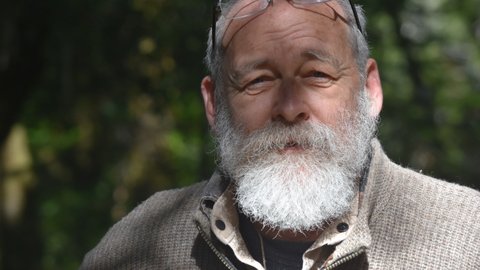
My 2 Cents
In 2000 after teaching much of 15 years mostly college I was now teaching science in a rural school in the shadows of the Sierra Nevada. I had been there for 2 years and I could not put my finger on what was different about this group of students and the students the high school students I had in 1985. They just were not happy and struggled with being in the classroom. They were awkward at running, befuddled if a problem required multiple steps, or had multiple answers. They could not get to sleep at night or stay awake during the day or when they were alert they fidgeted. They did not have much of what I considered common knowledge. Having been gone from the high school classroom for a decade the difference was like seeing your nephew one Christmas and not see him for 5. There was a marked difference. What was different? Where my expectations higher, was I becoming a curmudgeon in my early 40’s? Or were the kids different? I lay awake night thinking about this. I thought a lot about how I grew up.
As a little kid in the early 60’s I knew my happy place was being outside with nature, on the weekends and in the summer if my parents could not find me they knew I was down at the creek just being a kid. At the water’s edge I learned a great deal about many subjects, nature, and myself.
During the years I was gone from public school teaching some things happened genetics the basic person had not changed their environment had.
High stake state testing, school ranking by test scores, deleting vocational classes from the schedule, lots of homework, little or no free time, a majority of the kids were now being raised in daycare, they were no longer trusted to be out of sight by an adult, or their parents felt it was no longer safe for them to be free to play outside with friends. Gone were the days of hoping on the bike and to knock on a door and saying , “Can Johnny come out and play.” These kids had never had a chance to be in nature even though they were surrounded by it. How could they? They were under house arrest. Harry Harlow between 1932 and 1958 with his controversial work with reses monkeys depriving them of natural stimuli said one statement that summed up his work. “They failed to learn how to learn.”
They had never put a leaf in a stream to watch how travel over and around rocks in the water. Never saw a tadpole turn into a frog, a larva turn in to a mayfly or a dragon fly. Never watched a frog, trout, or bird catch a dragonfly. Or cut open a fish, rabbit, or dove and saw what was in it. Never held a pine cone, or stuck their nose in the bark of a Jeffery pine. They never ran through a creek jumping from stone to stone. Walk across a creek on a fallen log. There is an infinite about of scenarios that youth today never experience that were everyday occurrences 100 years ago.

In 2001 a New School Born With A Strong Nature Component
In 2001 by we threw out the standard model school, implementing 25 year of research. By 2009 we had implemented in our camps and school the core routines of nature connection listed here (as well as other routines that happy healthy successful people have done over time). Since then we have seen positive results. Kids that their sleep cycles are disrupted, that have been prescribed meds to balance the serotonin/melatonin dance in their brain, find that in nature, their circadian rhythms become normal. Research shows that the sun/fire light cycle not only resets the timing of these hormones but also increases the amount of melatonin that flows through the body and this hormone is the hormone of healing. Since 2001 with having our students days defaulted to be outside parents tell us they have seen a marked change in their children’s sleep patterns. We have seen this with many of our own students.
We have also experienced that as the school districts were reporting that student body were suffering from flu we were being spared. Was it because our school was small enough that our students were not being exposed? Was it because of an increase in melatonin? Was it because of a decrease serotonin? Was it because they were developing more physical grit because they were there bodies were experiencing a normal range in temperatures daily not fixed at 68 degrees? Was it because they immune system was no longer in a daily sterilized environment but being inoculated each day by the soil? Was it daily physical activity? Was it the lack of stress of the daily pressure of school, grades, tests, or large class sizes? Or is it because they are simply happier?
As the standard model school students have an increase in clinical depression our students are eager to come to school and reluctant to go home.
With 300 days each year spent with youth of all ages that spend at least 6 hours a day outside where we hike in and a mile or more I have watched a lot of our kids from age 6 and up, walk, run, and play. As we get students transfer, in to our program at any age, I would see a marked difference in their foot falls as they walk. As I drive home I see the kids from the district elementary, jr. high, and high school walking home and they walk the same way. Our students have remarked about it also. Is it a lack of muscle tone or agility? All you had to do was observe blend of our teens and teens for the district schools and homeschools, and you could pick out our kids simply from how they carried themselves.
I have spent my life listening to the sound scape in schools, play grounds, parks, and neighborhoods, and what I hear in our own school and camps. Toni said one day in a park, “Listen, there is not sounds of happy play.” Now that contrast is remarkable. I have listened to recordings of families in parks and kids in schools and listen to the background. When comparing recording from the 50s – the 70s and compare that with the sounds today in the same types of places. Back then laughter, giggling, and kids yelling with a fun tone a playful tone. Today the anthrophony is has less children in it and is predominated with adults yelling commands at kids, “Get your shoes on!” “Don’t run!” “Stand up you’re getting your cloths dirty!” “You share!” and most of the sounds of the children are unhappy, be it shouting commands at other kids, crying, or anger at adults or other children. I have spent the past ten years studying what the academics have discovered with happy successful people. Paramount is happiness is a habit, that happy successful people have many of the same daily routines, and have strong connection with nature. I have also spent the past 5 years working with hospice and Alzheimer’s patients and the fond memories mostly are anchored in being in nature. People that are near death or have been non-communicative smile, giggle, and laugh recalling their time in nature and this time has given me a great deal of insight into what how youth truly need to spend their time. These are just a few of our observations of many.
Jon Young introduces me to his core routines of deep nature connection in 2009, we added what we were missing to our own daily core routines and have had them in practice every day in our school and camps which have been a proving ground for these best practices in education and we have seen the long term effects of developing these as habits in our students and staff. The core routines listed and are described directly from Jon Young.
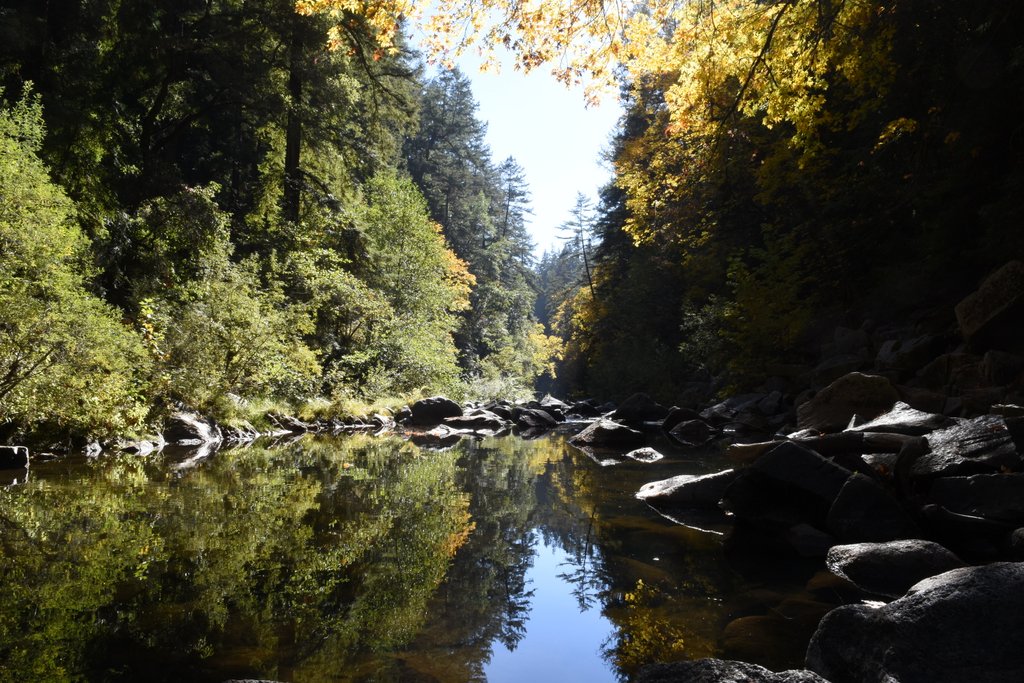
The Value of Nature
There is a growing body of evidence that our chemistry changes and physical changes happen with in our brains and body with time spent in nature doing what we evolved to do. For proper brain development and metal health youth need to have consistent time spent nature. Research shows that with an increase in time spent outdoors our youth have in decrease in the cases and severity of obesity, ADHD, mental Illness, and prescribed and illicit drug use. There is also evidence of an increase in resiliency, problem solving skills, health, and happiness.
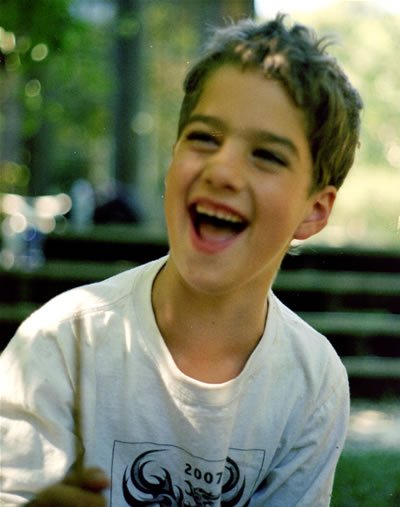
Since Richard Louv has brought the value of connecting kids to nature to the forefront with his book Last Child in the Woods there has been ample research to show the benefits of connecting to nature. But what is truly important to us is what we see in our own students. Youth of any age that enter our programs tend to not be sure how to play, are awkward crossing creeks, have a tendency to say “I am board”, demand that there is only one right way of doing things, tend to want to be first, last to want to help out, etc. After a few weeks of 6 hours per day 5 days per week in the backcountry mostly just following our core routines the students are calmer, walk taller, engage better with people both their own age and older, are much more agile in their movements, ask much better questions, have higher quality of problems and fewer problems, and smile and laugh much more. Parents say they are much nicer people, they want to know what we have done, but truly we just let nature do it.
Northwestern Outdoor Leadership Institute believes that it is necessary for people to first truly connect to a habitat to love that habitat, and only those that love that habitat will properly manage the habitat. What we do at Northwestern Outdoor Leadership Institute is to prepare the next generation of people to be proper stewards of the habitat and the wildlife that make it their homes.
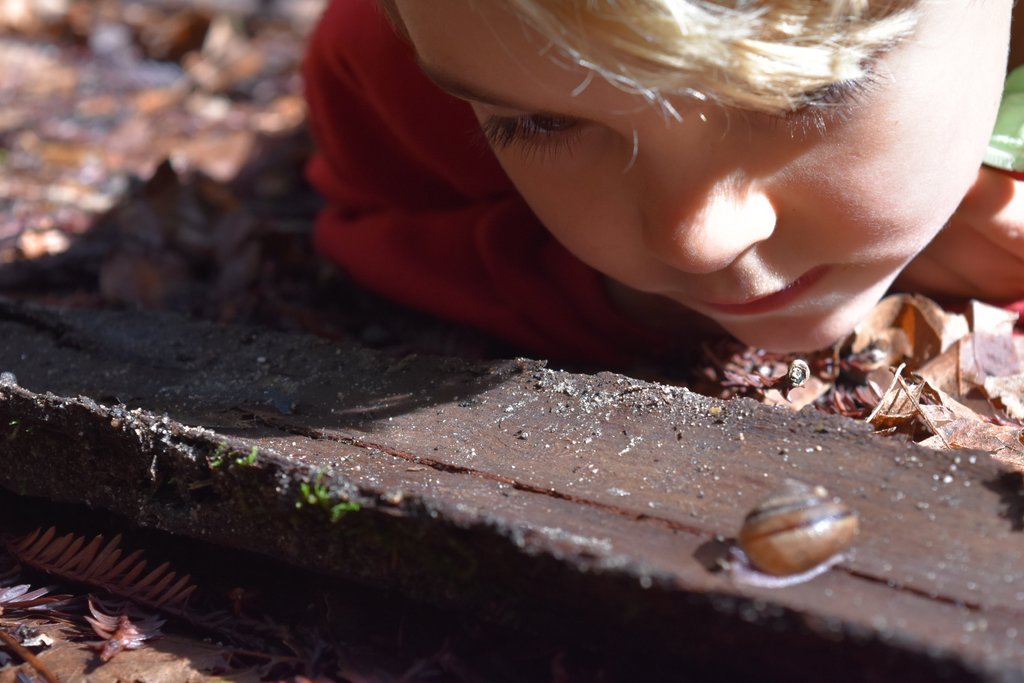
Using Core Routines to Connect Kids to Nature
“The Core Routines of Nature Connections are things people do to learn nature’s ways. They aren’t lessons. They aren’t knowledge. They are learning habits. Luckily for us as nature guides, shifting our mental habits into these Core Routines of Nature Connection comes as second nature to all human beings. This way of knowing was not born a few hundred years ago, or even with the rise of civilization thousands of years ago. Rather than informing, our teaching job educates ourselves and those we mentor to discover what the Haudenosaunee people call our “original instructions.” Humans evolved with original instructions designed for dynamic awareness of nature. If we can inspire practice of these Core Routines, remembering our original instructions will happen on its own.” Jon Young
The mentors at Northwestern Outdoor Leadership Institute model the following core routines and guide the students every day to make the core routines a habit. Northern California’s Bay Area has a wealth of natural beauty and is a wonderful place for observing plant and animal life at close range.

Sit-Spot
The idea is simple: guide people to find a special place in nature and then become comfortable with just being there, still and quiet. In this place, the lessons of nature will seep in. Sit Spot will become personal because it feels private and intimate; the place where they meet their curiosity; the place where they feel wonder; the place where they get eye-to-eye with a diversity of life-forms and weather-patterns; the place where they face their fears — of bugs, of being alone, of the dark — and grow through them; and the place where they meet nature as their home. Jon Young
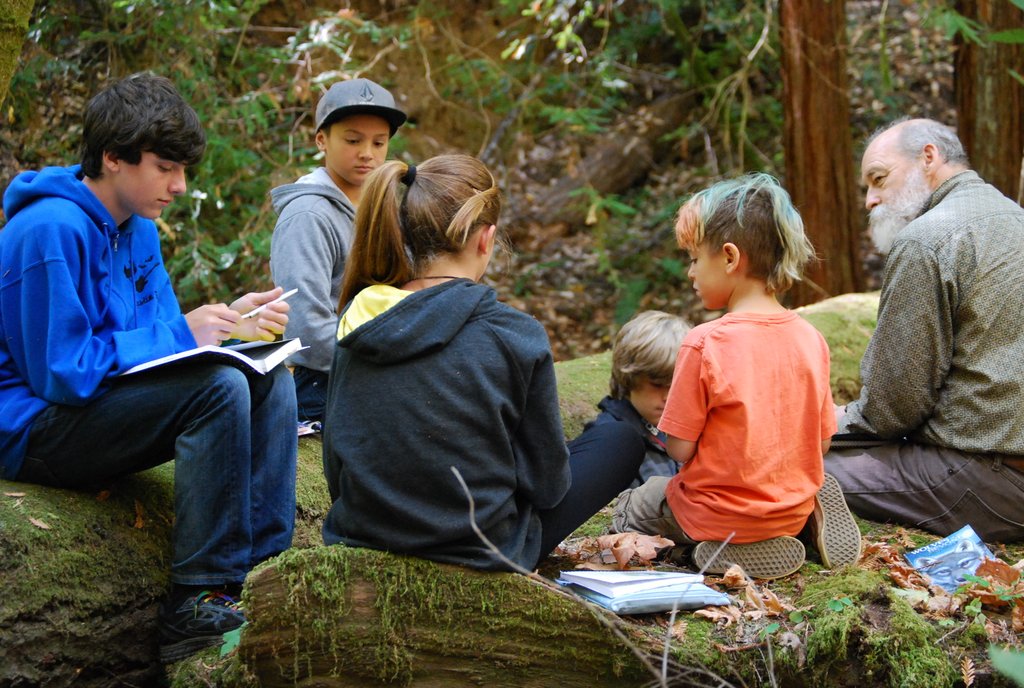
Story Telling
Story telling knits the society together. The men would go out for a day of tracking and hunting, while grandmothers and children might harvest berries, root vegetables, or bark to make thread and cloth. Around the fire at night they would gather and report the stories of their days. This exchange of stories seems to be very important to humans. Jon Young
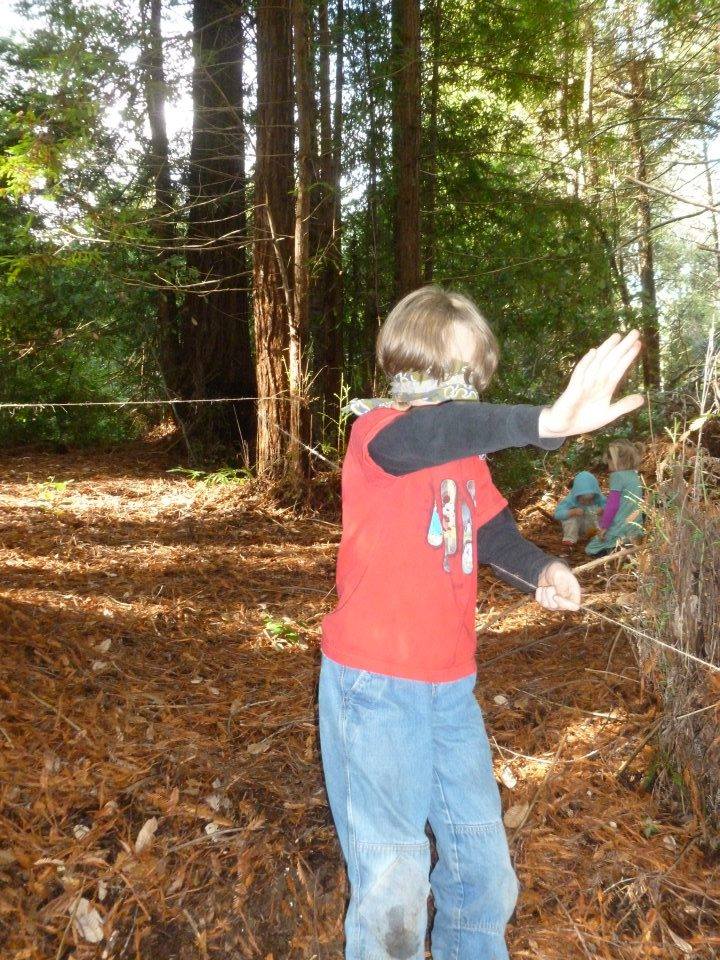
Expanding Our Senses
For nature connection, we use only one golden rule: notice everything. Get down in the dirt and feel it. Widen to Owl Eyes (a name we like to give to peripheral vision) and detect movement. Hear the far-off cry of the hawk and the wind in the trees. Smell the scent carried in the warm breeze. Feel the direction of sun. Taste the safe wild edibles. At every opportunity, we alert our students to expand their senses until doing so becomes routine, a practice, a habit, a discipline, and finally, a brain pattern. Jon Young
Questioning and Tracking
Who? What? When? Where? Why? How? Like peering through a window into wildlife, tracking animals can be endlessly fascinating. By capturing imagination and empathy, it demands whole-brain intelligence and concentration. Getting down on all fours and staring at the footprints of animals offers a particular abundance of opportunity for imprinting search images. Like reading, studying the sign and following the trails of animals, develops powers of pattern recognition that stay with you for the rest of your life.
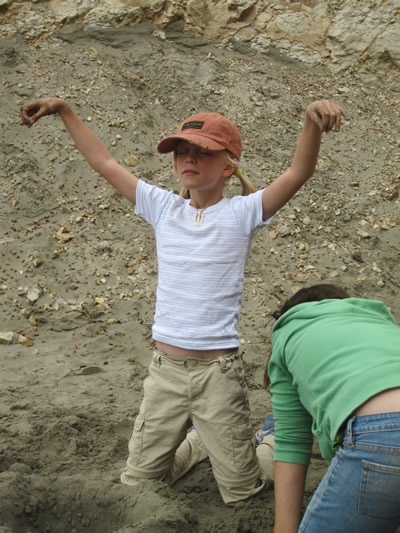
Animal Forms
Animal Forms in a Nutshell: Physically, mentally, and emotionally imitate any and all animals in their movements, behaviors, and personalities. A Long Tradition of Imitation This potent routine might seem a bit different from the others, more akin to dance than mental gymnastics. What we call Animal Forms simply imitates the physical and mental actions of animals, birds, and to some extent even grass, wind and water. This kind of practice can be found in cultures across the globe. For instance, think of the many martial arts from Asia based on imitation of animals, such as crane, tiger, or turtle. Also, many indigenous cultures conducted imitative dances and dramas, often with accompanying masks and costumes. The Hawaiian Hula, an ancient and modern dance form, brilliantly demonstrates such animal and nature dances. Cave paintings in Europe and old European stories indicate that the ancestors of Europeans did the same. The students through observation get in to their heads how the animals walk, run, eat, dance, and then in games the staff have the students model those animal forms.
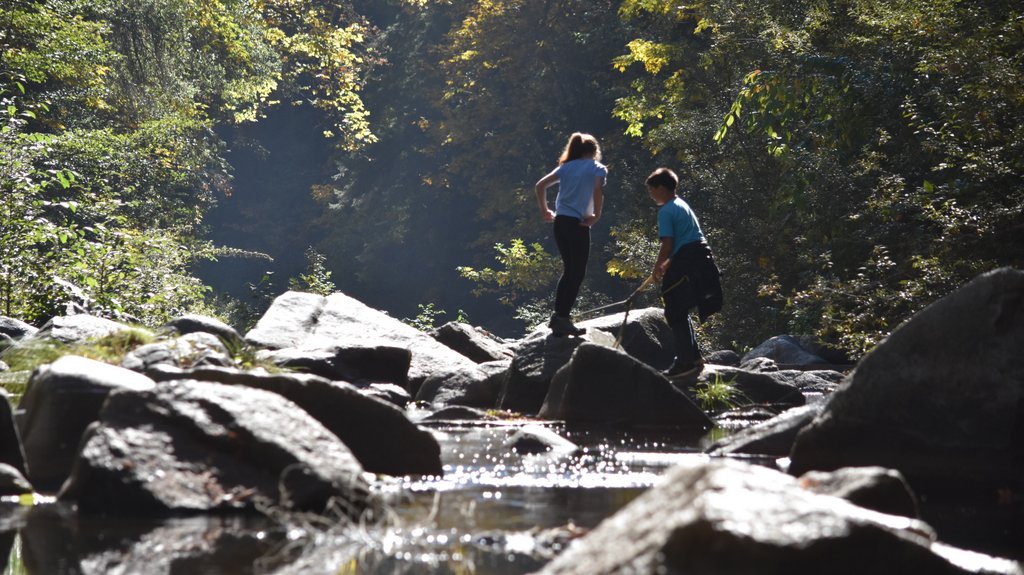
Wandering
Wander through the landscape without time, destination, agenda, or future purpose; be present in the moment; and go off-trail wherever curiosity leads. Hmmm…an educational activity without purpose? A walk in nature without a destination or intent? Are we serious? Unstructured Time Yes, we feel so serious about this routine, that most of our programs have a built-in “wander” or “walkabout” for about half of our time out in the field. We call this “The 50-50 Principle.” We plan our whole day to follow a structure, but count on fifty-percent of the time in the excitement of the moment, involving timeless, unstructured Wandering. There is nothing to accomplish, nowhere to go. By just being present in the moment, curiosity gently leads us wherever we go. Jon Young
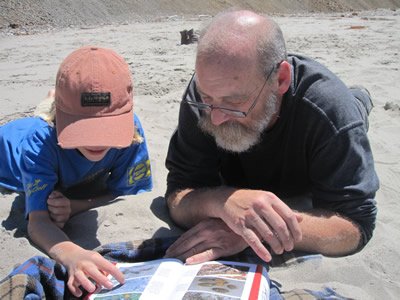
Exploring Field Guides
We an extensive naturalist library for the students to browse through field guides as treasure-chests of knowledge that fill up the vacuum of your curiosity about nature. When people want scientific information, how can we help them find it for themselves? Teaching them to Explore Field Guides makes them life-long, self-sufficient citizen-scientists of the natural world. Jon Young

# Mapping >Orient to the compass directions, and perceive the landscape from a bird’s eye view. Draw maps to locate features of the landscape or tell stories that map your explorations. A natural routine familiar to anyone who’s ever driven in a big city, mapping orients us and shows us the gaps in what we notice. It creates a need for people to know what bird that was by the swamp, or where that creek goes. It also brings the landscape to life as the diversity of natural signposts emerges through the connections between birds and berry bushes, between coyote scat and vole-filled meadows, between bodies of water and the daily movements of animals. Jon Young

# Journal >Stories can be told to a journal. With young children this might be done through drawing or art, or dictating to you, the writer. Again, we share many tricks for this which may depend on your skills and the skills objectives of your program.
Older youth journal tracks they find in the field, or write about Sit Spot experiences, keeping weekly “Field Inventorie”
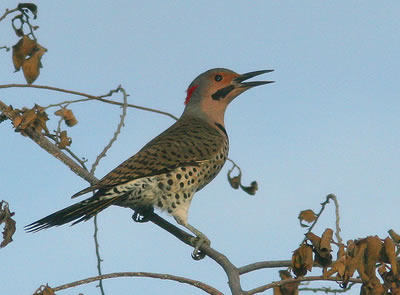
Listening for Bird Language
Be still and listen. Quiet down and crane your ears and eyes to notice the vocal signals and body language of birds and other animals, including humans. What message do you hear in their voice? Jon Young